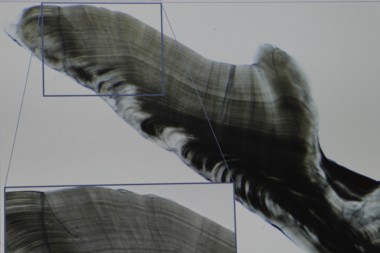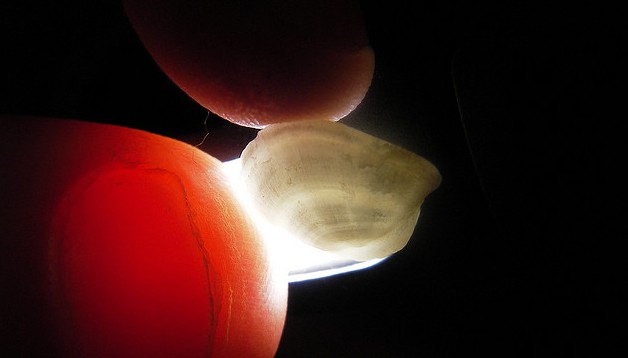Finding Answers in Unexpected Places

Many people wonder why natural history museums hold onto "all that old stuff" in their research collections. Well sometimes, all that old stuff can hold information critical to understanding our world. It's just a question of waiting until science matures enough to decode the information they hold. The Burke Museum’s collection of pollock otoliths is a great example.
Otoliths Archive Ocean Data
[jwplayer config="QUEST Video Player Inline II" mediaid="65346"]
Similar to the rings in a tree, otolith layers form rings that can be counted and measured to determine the fish’s age and growth over the years of its life. Most fish have three otoliths, commonly referred to as ear bones, at the rear of their skull to aid in balance, orientation and hearing. Otoliths are actually stone-like composites that develop layers of proteins and calcium carbonate from the fish’s birth until its death – offering a record of age, growth rate and reproductive age, as well as information about water conditions and climate change the fish experienced. Some fish, like rockfish, can live more than 100 years, giving researchers a rare glimpse into environments from more than a century ago.
 Thomas Helser, program director at the NOAA’s Alaska Fisheries Science Center (AFSC) Age and Growth Program, leads a team of experts in accessing the data within these fish “flight recorders,” as he describes them. Helser and his staff are collaborating with numerous governmental and academic colleagues in the fields of ecology, geology, evolutionary biology and archeology to explore cutting edge technologies that shed light on critical issues like climate change and overfishing. The team processes some otolith samples intensively for geochemical data. Others they cut in half, polish and lightly burn to enhance the rings, then count the rings to estimate age. Annual growth widths are measured to examine changes in growth over time.
Thomas Helser, program director at the NOAA’s Alaska Fisheries Science Center (AFSC) Age and Growth Program, leads a team of experts in accessing the data within these fish “flight recorders,” as he describes them. Helser and his staff are collaborating with numerous governmental and academic colleagues in the fields of ecology, geology, evolutionary biology and archeology to explore cutting edge technologies that shed light on critical issues like climate change and overfishing. The team processes some otolith samples intensively for geochemical data. Others they cut in half, polish and lightly burn to enhance the rings, then count the rings to estimate age. Annual growth widths are measured to examine changes in growth over time.
Man-made evolution
[jwplayer config="QUEST Video Player Inline II" mediaid="65350"]
For his research into sustainable fishing levels, Jeremy plans to sample more than 500 Alaska pollock otoliths collected as far back as the 1960s to look for changes in age, growth rate and reproductive age of the fish over time. Overfishing can cause fish to mature faster and reproduce at a younger age as a means to compensate for loss of reproductive capacity. This may eventually cause an evolutionary change through removing genetic traits associated with older, larger, more valuable fish.
Jeremy will pair what he learns from the otolith collection with population and environmental data collected by a range of people and organizations, to gain a deeper understanding of the relationship between the size and age of mature fish, and the volume of fishing happening at the time. “I hope to put this issue on the radar so people start thinking about longer-term evolutionary impacts of fishing,” says Jeremy.
Thanks to a grant from the National Science Foundation, Jeremy is also helping to transfer more than two million otoliths collected by NOAA over the past 50 years to their new, permanent home as part of the Burke Museum’s fish collection. There they will be held safely, until the day that science finds a new way to unlock their precious data.




